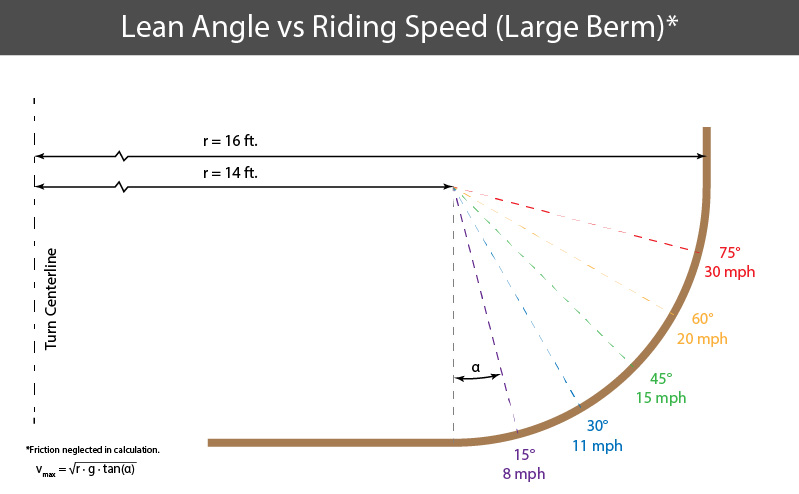The IFP wood berms are all constant radius but #1 (the biggest) and #3 drop about 5' of elevation and riders will gain speed through them (about +4mph). This effectively makes them feel like a tightening radius turn. #3 is the most challenging because the elevation drop is the greatest/quickest and it's radius is also the tightest of the three at 12'. To account for the increased speed as you ride through berm #3, the bike needs to be leaned an additional 10-15 degrees by the exit of the corner to maintain the turn.
The IFP wood berms are a totally different animal than the SBP wood berms and they can't be ridden the same way. Curved face berms force riders into a specific line based on speed alone. Riders can't do much steering correction once committed to the turn so setting up for it properly is key.
Flat plank berms with shallow bank angle, like the SBP berm bridge, allow much more flexibility of line choice. The berm bridge is also a larger radius (19-22') and much wider (4'). I think the bank angle is around 35 degrees also.
If a rider gets too high on the IFP berms without leaning, the front tire can lose traction resulting in a highside crash over the bike. This can also cause a fall over the top of the berm. From what I've seen, not leaning enough and trying to ride too high on the berm is almost always why people crash on them. The key is leaning the bike into the berm so the tires are perpendicular to the curved deck.
This is an example of a poor line. The front tire is trying to climb over the berm and is at a very steep angle to the deck (a low traction state). Rider is not leaning enough into the berm. Also notice the tires are at two different heights on the berm and if you draw a line connecting the contact patches, they don't point through the turn.
This is a good line example. Bike is leaned so tires are perpendicular to the planks (maximum traction state), rider is positioned about half way up the bank, and the tires are at the same height and a line through the contact patches follows a "level" path through the berm.
I posted this diagram a while ago showing the theoretical speeds for IFP berm #1 in this thread: Tips for Riding the New South Loop Wood Berms Angles and speeds will be a little different for berms #2 & #3 than shown in this diagram, but the general idea is the same: Lean the bike!








 Reply With Quote
Reply With Quote